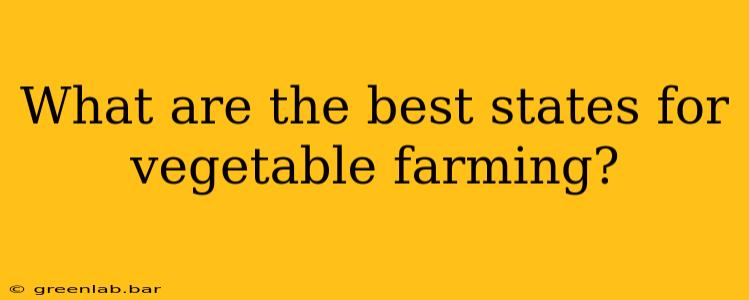The United States boasts a diverse range of climates and soil conditions, making it a prime location for vegetable farming. However, some states consistently outperform others due to a combination of favorable weather patterns, fertile land, established infrastructure, and access to markets. This article explores the top contenders for the best states for vegetable farming, examining factors beyond just sheer production volume.
Key Factors Determining Vegetable Farming Success
Before diving into specific states, let's understand the crucial elements that contribute to a thriving vegetable farming industry:
-
Climate: A long growing season with moderate temperatures and sufficient sunlight is essential. Too much heat or frost can severely impact yields. Access to water, either through rainfall or irrigation, is also critical.
-
Soil Quality: Fertile soil rich in organic matter provides the foundation for healthy plant growth. Soil testing and amendments are vital to maintain soil health and productivity.
-
Infrastructure: Efficient transportation networks are crucial for getting fresh produce to markets quickly. Access to processing facilities and cold storage can extend shelf life and reduce waste.
-
Market Access: Proximity to major population centers or established distribution channels ensures a ready market for the harvested vegetables.
-
Labor Availability: A reliable workforce is necessary for all aspects of farming, from planting and harvesting to packing and shipping.
Top States for Vegetable Farming: A Detailed Look
While many states contribute to the nation's vegetable production, some stand out due to the combination of factors mentioned above:
1. California: The Undisputed King
California reigns supreme in vegetable farming, accounting for a significant portion of the nation's production. Its diverse microclimates allow for year-round growing of a vast array of vegetables. The Central Valley, with its fertile soil and irrigation systems, is particularly productive. Strong infrastructure and proximity to major markets solidify California's leading position. However, water scarcity is an increasing concern that the state is actively addressing.
2. Florida: A Southern Powerhouse
Florida's subtropical climate allows for extended growing seasons, especially for winter vegetables like tomatoes, peppers, and cucumbers. The state benefits from access to both domestic and international markets. However, challenges include susceptibility to hurricanes and the need for effective pest and disease management.
3. Arizona: Thriving in the Desert
Arizona's arid climate might seem counterintuitive, but advanced irrigation techniques and access to water resources allow for substantial vegetable production, particularly in the Yuma and Phoenix areas. The long growing season and efficient farming practices make Arizona a key player in winter vegetable production.
4. Washington: Northwest Excellence
Washington's temperate climate and fertile soil are particularly suited to growing potatoes, onions, and other root vegetables. The state also produces significant quantities of other vegetables, benefiting from its strong agricultural infrastructure and proximity to major population centers.
5. Texas: Diversity and Scale
Texas' vast size and diverse climates allow for the cultivation of a wide range of vegetables. The state's strong agricultural tradition and infrastructure support large-scale vegetable farming operations. However, challenges include variable weather patterns and water availability in certain regions.
Beyond the Top Five: Other Notable States
While the above states dominate in vegetable production, several others deserve mention for their specific contributions: Idaho (potatoes), Michigan (sweet corn), Wisconsin (potatoes and sweet corn), and New York (onions and other vegetables).
Conclusion: More Than Just Production
The "best" state for vegetable farming depends on various factors, including the specific vegetable being grown, the scale of the operation, and access to resources. While California holds a clear lead in overall production, other states excel in specific niches. The future of vegetable farming will likely involve further innovation in sustainable practices, water management, and technological advancements to overcome challenges and ensure a consistent supply of fresh produce for the nation.

